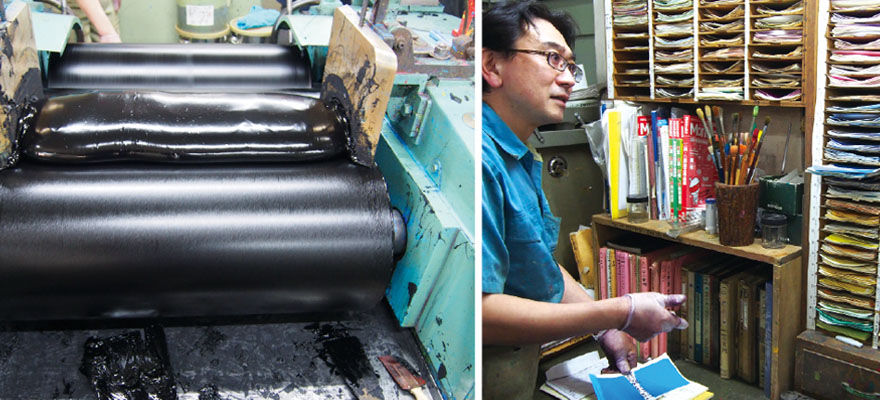Home > Highlighting JAPAN >Highlighting Japan December 2013>Japan's technological achievements
Highlighting JAPAN
Japan's technological achievements
Nicker Paint
The magic behind the artist

Japan's manga and animation have exploded in popularity all over the world and have come to represent Japan's pop culture.
The Nerima Ward of Tokyo is often said to be the birthplace of anime. Fittingly, it is also the location of Nicker, the paint brand used by many leading manga and anime artists, including Hayao Miyazaki, the genius behind such beloved films as My Neighbor Totoro and Spirited Away.
Ichiro Tsumakura is the current president of this 64-year-old company. In his office decorated with paintings by artists and art school students, he points to one image in particular. It was done on the spot by an artist from Miyazaki's Studio Ghibli. The sky in the painting is a combination of a whole range of blue, while the cloud seems so light that it might literally float out of the paper, a familiar sight in Ghibli works.
Gazing at the picture, Tsumakura says, "Instead of making children draw ordinary posters in school, they should get teachers to do demonstrations like this, and allow children to create their own versions of Ghibli. You have to give them a dream, a hope. If not, art will have no meaning."
There are up to 600 colors for certain types of Nicker paints. "We get many requests from clients to make colors that are between two very similar shades," Tsumakura notes. For example, when Tetsuwan Atomu (Astro Boy) premiered on national television in 1963, Osamu Tezuka's production staff came to the factory to choose his colors. But out of the standard 1-6 range, he could not find a single shade of black that suited Astro Boy's boots. This led Nicker to create a new shade of black between 3 and 4, now named 3.5.
When color television began two years later, Tezuka's production staff again paid Nicker a visit, this time to choose the color of the sky. "When we finished making the color he requested, Tezuka exclaimed in satisfaction, 'This, indeed, is the color of the sky!' That color is now Silurian blue."
While animation made with Nicker paint may be known around the world, the same cannot be said of Nicker itself. Tsumakura is working to change that, aiming to increase the appeal not only of his paint but also his factory. Last summer, he made a poster entitled "Let's visit the paint factory" and sent it to Nikkei Sangyo Shimbun, one of Japan's top industry newspapers. This resulted in 700 people, mostly parents and children, visiting the factory to discover how paint is made.
Tsumakura is also working on projects to help address environmental and social concerns such as graffiti in cities. He organizes fresco painting events all over the country, with one recent example occurring at a site just a five-minute walk from Tokyo's Shimo-Kitazawa Station. In a 600-square-meter space that was once a graffiti-covered parking lot, visitors can now find a recumbent giraffe painted on the 2-meter walls. Initiated by a request from the lot owner,the project took eight days
to complete.
In the MRI room of a children's hospital, pictures of animals have been drawn on the wall and even on the machine itself, with warm colors that help the children feel at ease.
In one effort to combat truancy in high schools, the doors of all the cubicles in a girls' washroom were painted to form an impressive mural, contributing to an increase in attendance.
Despite all of its projects, Nicker still operates with only 17 employees. "Having a small group of employees means that decisions are made quickly," says Tsumakura. "It also means having time to sit down with each and every one to hear his or her thoughts on the work environment and upcoming projects. We are like a family here."
Considering all the beloved family films that take life from his paints, that sounds just about right.
© 2009 Cabinet Office, Government of Japan






